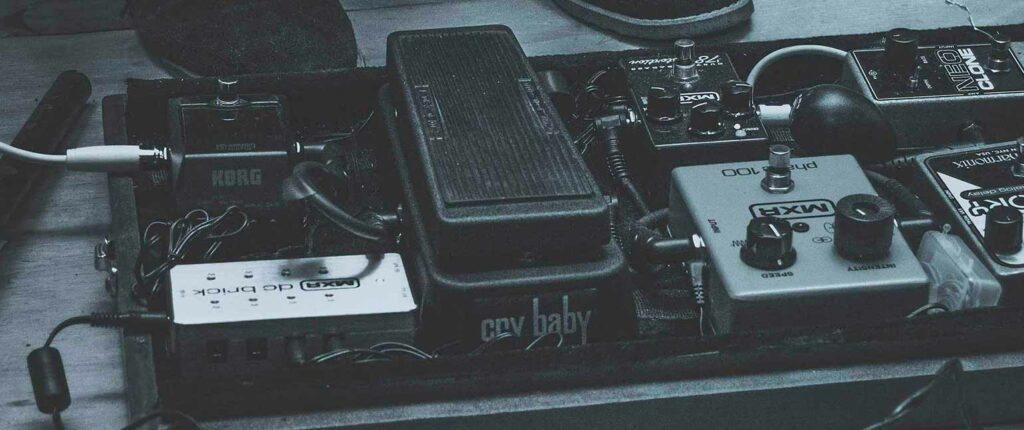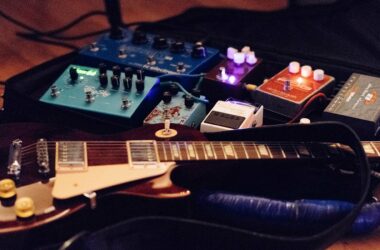If there’s one pedal that any music neophyte knows, it’s the wah-wah, that iconic pedal in the history of music. In this article, we explore the fascinating world of wah-wah pedals, from their unique sound to their evolution over time.
What is a Wah-Wah?
The wah-wah is an interactive effects pedal that modifies the tone and timbre of an electric guitar by creating a moving filter effect sweeping across different frequencies of the audio spectrum.
To go into more detail, inside the pedal are a rotary potentiometer and an inductor that form an oscillating circuit. By activating the pedal with his foot, the guitarist modifies the position of the potentiometer, thus varying the filter frequency. This creates the sweeping effect characteristic of wah-wah, that distinctive sound similar to that of a human voice pronouncing the syllable “wah” (used notably in so-called “talkin’ blues”).
This expressive, identifiable effect has been widely used in various musical genres, from rock and funk to blues and jazz.

The history of wah-wah:
The birth of wah-wah dates back to a chance innovation in the 60s. US engineer Bradley J. Plunkett, tasked with reducing production costs for Vox AC-100 amplifiers while preserving sound quality, transformed a simple switch into a cheap potentiometer. Experimenting with this circuit, he discovered the characteristic sound of the wah-wah. by varying the boosted frequency. To make this effect accessible to guitarists, Plunkett came up with the ingenious idea of adapt an organ volume pedal into a foot controller. Originally, however, the pedal was designed for trumpet players (imitating the effect of a trumpet mute).
Released in 1966 under the name Vox Clyde McCoy Wah-Wah, this creation marked the beginning of a sonic revolution in the world of electric guitar. Legends such as Jimi Hendrix and Eric Clapton quickly adopted this new sound, propelling the wah-wah to the status of musical icon.
Some iconic wah-wah pedals
Some wah-wah pedals have left an indelible mark on the history of music:

1. Vox Clyde McCoy wah-wah
The Vox Clyde McCoy Wah-Wah is one of the first wah-wah pedals to conquer the music world. Popularized by Jimi Hendrix (who actually had several, just in case his broke down or had a problem…), its name is associated with a distinctive, expressive sound. This pedal paved the way for the creative use of wah-wah in rock and blues.
2. Dunlop Cry Baby
The Dunlop Cry Baby is perhaps the most iconic and widely used wah-wah pedal of all time. Popularized by guitarists such as Eric Clapton and Jimi Hendrix, the Cry Baby is renowned for its simple design and rich sound. It comes in a variety of versions, each with its own signature sound.
Did you know the origin of the name Cry baby?
The Dunlop Cry Baby wah-wah pedal takes its name from an amusing anecdote. When the first version of the pedal was presented to a group of musicians, one of them commented that the pedal made the guitar sound like a “cry baby”. The name stuck, becoming emblematic.


3. Morley Bad Horsie wah
Designed in collaboration with guitarist Steve Vai, the Morley Bad Horsie Wah brought a major innovation by introducing a rather atypical operation in the wah world: the pedal is activated by motion-sensing technology, so as soon as the guitarist puts his foot on it, the pedal detects it and engages the effect. As a result, it offers fluid control of the sound spectrum and has become a benchmark in the world of instrumental rock.
4. Fulltone Clyde Deluxe wah
The Fulltone Clyde Deluxe Wah is a modern reinterpretation of the original Vox Clyde McCoy. It combines vintage elements with modern enhancements, offering a wide range of wah sounds. This pedal is appreciated for its versatility and ability to reproduce classic wah tones.


5. Ibanez WH-10 wah
The Ibanez WH-10 Wah is a classic wah pedal that has found its place in studios and on stage. Used by guitarists such as John Frusciante of the Red Hot Chili Peppers, it’s renowned for its simplicity, its robust on/off pedal switch, and its expressive sound, which has left its mark on many musical productions.
Artists and wah-wah anecdotes
Jimi Hendrix
Hendrix used the Vox Clyde McCoy Wah-Wah, helping to popularize the effect in such iconic tracks as “Voodoo Child (Slight Return)” and “Up from the Skies”.
Eric Clapton
Clapton incorporated wah-wah into his arsenal, notably with the Vox Clyde McCoy pedal. Its use on Cream’s “White Room” remains emblematic.
Frank Zappa
Frank Zappa experimented with wah-wah in an avant-garde way (he was the first guitarist to use this pedal). “Willie the Pimp” is an example where he uses this effect to create unique sonic textures.
Isaac Hayes
In his performance of “Theme from Shaft”, Isaac Hayes used wah-wah on his Hammond B3 organ, adding a funk dimension to this soul classic.
Eddie Van Halen
Eddie Van Halen incorporated wah-wah in a distinctive way in his legendary solo “Eruption”. His use of the effect is often cited as influential in the world of hard rock. Van Halen is also known for modifying his wah-wah pedal to create a more distinctive sound. He removed the pedal mechanism, transforming the wah-wah into a hand-controlled expression pedal, offering more precise control over the effect.
Kirk Hammett (Metallica)
In “Enter Sandman”, Kirk Hammett uses wah-wah to create dramatic effects, demonstrating how this effect can be integrated into the context of heavy metal.
Where to place the wah-wah on your pedalboard?
Typically, the wah-wah is placed at the very beginning of the chain, directly after the guitar. This configuration allows the effect tomodulate the raw guitar signal before any further tonal manipulation. However, there is one important exception: some fuzz pedals require a high-impedance signal and must therefore be positioned in the first position, directly behind the guitar. In order to determine the best order of arrangement between wah-wah and fuzz, it is advisable to carry out tests to obtain the optimum sonic result.
If you’d like to find out more, take a look at our complete guide to pedalboard chaining!
Wah-wah, love it or leave it!
The wah-wah is the mythical guitar effect par excellence and remains a staple in many a guitarist’s arsenal, being capable of transforming a simple melody or solo into a deeply expressive sonic experience. However, love for wah-wah is not universal, and there seem to be two well-defined camps among guitarists: those who simply can’t do without it, and those who wouldn’t use it for anything in the world!










